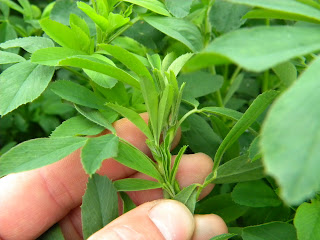A case in point is the latest weather data. If I asked you whether May 2011 has been below, the same, or above for heat accumulation when compared to the 30 year average, what would you would say?
I could post a poll on this blog to track results, but let's cut to the chase. Sunny warm days make us feel good, wet cloudy days make us feel lousy. With many more wet cloudy days than sunny days in May, I tend to think most would say heat accumulation has been below average. Agree?
Here is the evidence to date.
We experienced a lot of daytime highs from 10-18 C and nightime lows were usually around 10C. Do the math and you get about 400 heat units.
But, I hear you say, "it was wet and cloudy, this can't have the same effect as dry and sunny". Fair enough. All I know is I am not smart enough to factor in sunlight intensity with respect to growth. If any of my readers can, there may be a decent research job waiting.
This little guy is showing the effect of cloudy weather. But he is up and a clear demonstration that there has been enough heat, about 250-300 heat units, to get him this far. And with some sunny weather he will turn bright green.
The secret is being smart enough to know what we think we know, may not be what we know.































